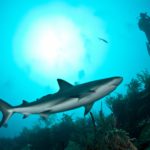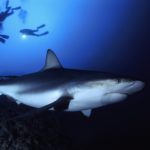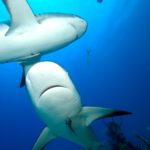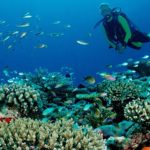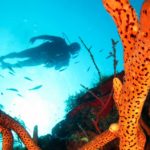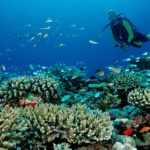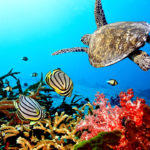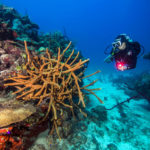DIVING
Jardines de la Reina
Gardens of the Queen was named by Christopher Columbus to honor the Queen of Spain and the area remains as spectacularly beautiful and wild as when Columbus experienced it centuries ago. Today, it is the largest no-take marine reserve in the Caribbean and among the healthiest marine ecosystems in the region. Unlike other parts of the Caribbean, countless coral and fish populations are thriving at the Gardens. You’ll see massive stands of elkhorn coral (Acropora palmata), which has diminished by nearly 95 percent in the Caribbean during the last 40 years.
The robust fish populations that call the Gardens home include bonefish, Cubera snapper, and the critically endangered Nassau and Goliath grouper. Covering more than 837 square miles, the Gardens also harbors an abundant shark population, including silky sharks, Caribbean reef sharks and whale sharks. But there’s more: the area has spectacularly healthy mangrove islands and shallow bays that teem with juvenile species, including rare crocodiles and the jutia, a native rodent.
In a world where many of the oceans’ corals and fish populations are in decline, the marine life of Cuba’s Gardens of the Queen is thriving. The massive and strikingly beautiful Gardens of the Queen National Park is located 60 miles off the southern coast of Cuba, an archipelago comprising a chain of 250 virgin coral and mangrove islands extending along 75 miles of turquoise waters.
Zapata
BAY OF PIGS – Zapata Peninsula Park was declared by UNESCO to be a biosphere preserve. Cienaga de Zapata is the largest wetland in the Caribbean, located on the Zapata Peninsula 177 km south-east of Havana, known as Bay of Pigs – Bahia de Cochinos.
Isolated and serene, the Cienaga de Zapata is an ecotourism and diving area famed for its marine species, coral reefs and birds. The National Park is well known for local endemic Cuban crocodile and is one of the best bird watching areas in the Caribbean. Swamps, countless canals and natural watercourses are typical of the rugged landscape of the Zapata Peninsula.
The Bay of Pigs is an extensive ecosystem with spectacular wall dives, beautiful coral gardens, cenotes, and crystal clear waters. It is an idyllic playground for Eco tourists and scuba divers, the area is sparsely populated and zealously protected, most of the region lies within the Ciénaga de Zapata Biosphere Reserve a habitat of rare birds, crocodiles and a wide variety of ecosystems. Highlights within the biosphere are the Parque Nacional Ciénaga de Zapata and Laguna de las Salinas, known for its concentration of migratory birds. The Parque Nacional Ciénaga de Zapata is similar to the Everglades National Park in Florida but more unspoiled.
This ecosystem is made up of mangrove forests, keys, seagrass beds, coral reef barriers and deep reefs, including the Cazones Gulf, a deep underwater canyon that is the main recruitment site of important commercial species such as porgies and groupers. The conservation status of coral reefs in the area is very remarkable; it comprises an important system of gyre-like currents.
This territory is characterized by both the presence of considerable peat depth and the fact that it is a low, flat area from the viewpoint of relief. Top height above sea level is only about 10 meters, while top depth in below-sea-level coastal zones is as follows: 2 meters in the salt-marsh area and from 1- 600 meters in the sea coastal zone.
It is also a birdwatcher’s paradise, on the migratory routes between the Americas and home to endemic species such as the Zapata rail and Cuban pygmy owl. Despite its beaches and over 30km of accessible Caribbean coastline, Península de Zapata holds little appeal as a sun-and- sand holiday destination, but it is an excellent area for diving, with crystal clear waters, coral reefs sometimes also within swimming distance of the shore and a small network of flooded caves known as cenotes.
It was also one of Fidel’s favorite areas because of the 1961 victory. (There is a Fidelʼs Island)
Underwater walls are covered with sponges and black coral with a multitude of caverns with lots of fish. For decades, it has been a military area, which entails that the entrance has been forbidden until only recently.
One of the best dives is Canon de Cayo Blanco (from -10 to – 40 meters) is a beautiful coral garden, colorful, with a lot of reef fish. Around 17 meters deep it opens into a canyon wall that sinks into the deep blue. The wall is spectacular, covered with corals and sponges. In the blue you can see eagle rays, sharks and dolphins among other species. It is a stretch of unspoiled coastline, away from all the tourist routes and completely pristine.


